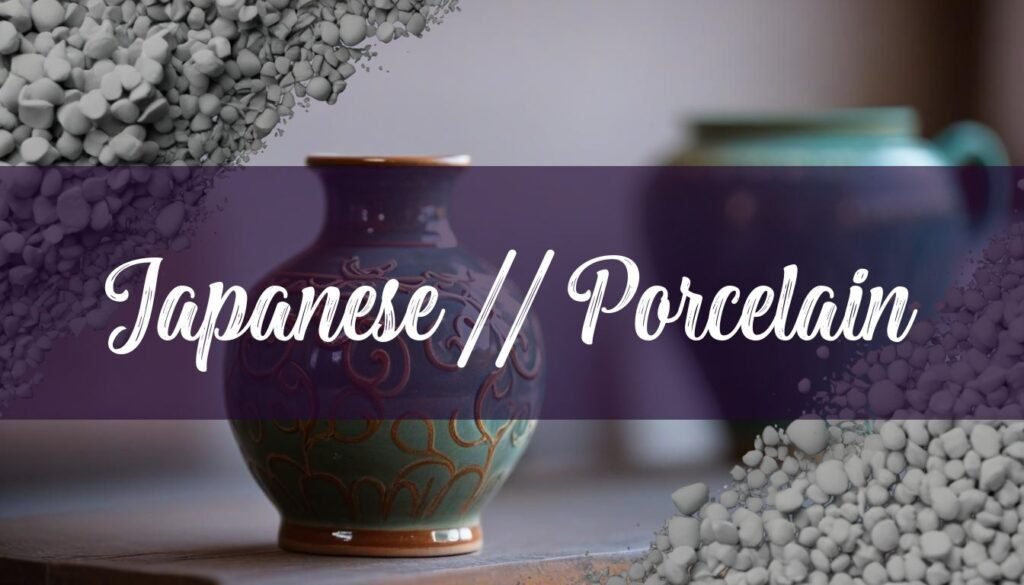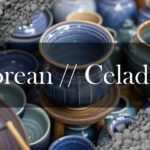Japanese porcelain, a term that encompasses a rich tapestry of ceramic artistry, is generally referred to as “jiki” (磁器) in Japanese, distinguishing it from “toki” (陶器), which denotes pottery and stoneware (more about Japanese ceramics here). This distinction is crucial, as it sets the stage for understanding the diverse landscape of Japanese ceramics, each with its unique history, characteristics, and regional significance. From the earliest porcelain production in Arita to the intricate designs of Kutani ware and the refined elegance of Imari, Japanese porcelain represents a remarkable fusion of technical skill, artistic innovation, and cultural expression. The journey through its various types reveals not only the evolution of ceramic techniques but also the profound influence of Chinese and Korean traditions, adapted and transformed into uniquely Japanese forms. The history of Korean Celadon, with its jade green legacy, had a profound influence on Japanese pottery.
Arita, Kutani, Imari, and Seto: A Regional Exploration
The story of Japanese porcelain begins in the early 17th century in the Hizen-Arita region of Kyushu, where porcelain production first commenced, employing techniques imported from Korea (learn more). According to tradition, Yi Sam-pyeong, one of the Korean potters brought to Japan during Toyotomi Hideyoshi’s invasions of Korea in the 1590s, discovered a source of porcelain clay near Arita, paving the way for the creation of the first Japanese porcelain (more info on this topic). These early wares, initially emulating the blue-and-white porcelain of Jingdezhen in China, quickly evolved, incorporating overglaze enameling techniques also acquired from China (continue reading). This marked the birth of what would become known as Imari ware, named after the port of Imari from which these exquisite pieces were shipped to markets across Japan and, eventually, Europe (learn more). Arita ware, under the “Imari” umbrella, is known for its white finish adorned with vibrant motifs, particularly the enchanting indigo blue and red patterns, adding an irresistible charm to these exquisite pieces (exquisite pieces here).
Kutani ware, originating from the southern region of Ishikawa prefecture, stands out for its vibrant hues and intricate patterns that exude elegance (Kutani ware). Its evolution can be observed through distinct styles from different periods, with the “Ko-Kutani” (古九谷) style, characterized by the classical five-color style called “Gosai-de” (五彩手), gaining immense popularity (learn more). Seto ware, on the other hand, is one of the most beloved styles of Japanese ceramics, serving as an umbrella term for a myriad of pottery styles (more details). With a history dating back over 1,000 years, Seto was among the first to glaze their earthenware, becoming some of the most collectible and revered of all Japanese ceramics (Seto ware).
Each of these regional varieties showcases not only distinct aesthetic qualities but also unique technical approaches to porcelain production. For instance, Kutani ware is produced through a meticulous process involving quarrying, clay making, molding, firing, underglaze painting, and overglaze painting, requiring a high level of skill and dedication from artisans (Kutani ware process). The main raw material for Kutani ware is pottery stone, specifically Hanasaka pottery stone, characterized by its high iron content, giving the finished clay a rich, grayish-white color (more on this stone). Imari ware, with its origins in Arita, benefited from the introduction of improved kiln technology from Korean potters, enabling temperatures of 1,400 °C (2,550 °F) to be reached (Imari ware). These regional variations underscore the diversity and artistry inherent in Japanese porcelain, each reflecting the unique resources, techniques, and artistic sensibilities of its place of origin.
Influences and Transformations: Shaping Japanese Porcelain
The development of Japanese porcelain was significantly shaped by influences from both Chinese and Korean ceramics. From the 4th century AD, Japanese ceramics have often been influenced by the artistic sensibilities of neighbouring East Asian civilizations such as Chinese and Korean-style pottery (pottery details). Japanese ceramists and potters took inspiration from their East Asian artistic counterparts by transforming and translating the Chinese and Korean prototypes into a uniquely Japanese creation, with the resultant form being distinctly Japanese in character (Japanese creation). The initial production of Arita ware, for example, directly emulated the blue-and-white porcelain of Jingdezhen in China, showcasing the early adoption of Chinese techniques and aesthetics (Arita ware). Similarly, the introduction of the anagama kiln, a roofed-tunnel kiln on a hillside, and the potter’s wheel in the 3rd to 4th centuries AD, came to Kyushu island from the Korean peninsula (more on this).
However, Japanese potters and artisans did not merely replicate these foreign styles and techniques; they adapted and transformed them to create distinctly Japanese forms of expression. This is evident in the development of overglaze enameling techniques in Arita, which allowed for more vibrant and colorful designs compared to the traditional blue-and-white porcelain (vibrant designs). The influence of the tea ceremony, particularly the wabi school of the cult, which emphasized rustic simplicity, also played a crucial role in shaping the aesthetic of Japanese ceramics, favoring humble Korean tea bowls and domestic ware over sophisticated Chinese porcelain (learn more). This shift in aesthetic preference led to the development of unique styles such as Shino, with its thick, crackled glaze, and Oribe, featuring vibrant green copper glazes and bold patterns (unique styles). Furthermore, the story of Japanese ceramics is also the history of Japan’s religions, belief systems, cultural and national values and it’s dynasties, wars, successes and failures (Japanese history). Japanese Tea Ceremony wares are a fundamental part of Japanese pottery history.
The interplay between foreign influence and local adaptation is a defining characteristic of Japanese porcelain, resulting in a diverse and dynamic landscape of ceramic art that reflects the country’s unique cultural identity.
From the early emulation of Chinese porcelain to the embrace of Korean techniques and the incorporation of indigenous aesthetic principles, Japanese potters have consistently demonstrated a remarkable ability to synthesize diverse influences into uniquely Japanese creations.
Authenticating Japanese Porcelain
Identifying authentic Japanese porcelain requires careful attention to various marks, features, and characteristics that distinguish it from imitations or reproductions (identifying tips). Porcelain marks serve as identifiers for collectors, assisting in the authentication and evaluation of pieces (collector tips). These marks may include the name of the factory, the potter, the decorator, the pattern, the customer, the exporter, the importer or both or a part of them or maybe just say “Made in Japan”, “Japan”, “Nippon”, “Happiness” or “Good luck” in any number of ways (various identifiers). The entire range of Imperial reign marks so common on Chinese porcelain, genuine or not, is mostly lacking (lacking range). Examining the base of the piece, researching kanji characters, comparing with reference books, and engaging with collectors’ forums are all essential steps in the authentication process (researching process).
One of the most important factors in identifying authentic Japanese porcelain is the presence of specific marks indicating the manufacturer, style, or age of the piece (important factors). For example, Kutani porcelain marks often feature the character “Kutani,” along with additional kanji indicating the artist or period of production (Kutani porcelain). Similarly, pieces marked with “Nippon” are generally considered to have been made before 1921, as this was the term used on porcelain exported to the U.S. before that year (pieces marked). The McKinley Tariff Act was instated, requiring items imported into the United States to be marked in English with the country of origin (Tariff Act). The name “Nippon” was chosen for items coming from Japan (Nippon).
In addition to marks, other features and characteristics can help distinguish authentic Japanese porcelain. The quality of the porcelain itself, including its whiteness, translucency, and texture, can be indicative of its origin and age. The style of decoration, the techniques used, and the overall aesthetic of the piece can also provide clues about its authenticity. By carefully examining these various elements and consulting with experts or reference materials, collectors and enthusiasts can gain a deeper understanding of Japanese porcelain and enhance their ability to identify genuine pieces.




